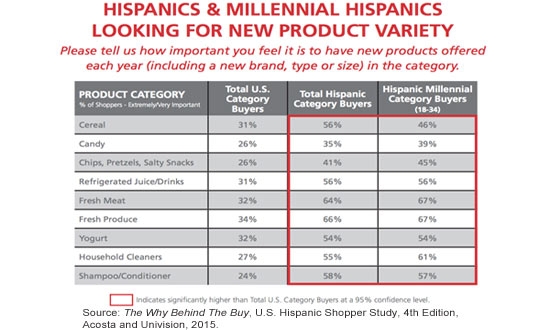
Indeed, Facts, Figures & The Future (F3) anticipates a food future led by this sector whose members are more optimistic foodies than whites and could well become the next generation of food brand and food retail innovators. Hispanic millennials might be especially motivated to fill a gap if today's mainstream supermarkets fail to satisfy their distinct food, beverage and alcohol preferences or respect the roles of food in their culture.
The nation's 83.1 million millennials are “far more diverse than the generations that preceded them, with 44.2% being part of a minority race or ethnic group,” state 2014 U.S. Census Bureau figures. Also, the nation's children under five became “majority-minority for the first time [50.2%],” Census says.
Within this context, the youngest generations of Hispanics outpace the numbers of older Hispanics in the U.S. Millennials already account for 27% and Generation Z 35% of the nation's Hispanic population, according to Geoscape. Some 40% of Hispanic millennials are foreign-born, notes Experian Simmons. Yet Pew Research Center says 68% of Hispanics in the U.S. are proficient in English, up from 59% in 2000.
According to the ThinkNow/Sensis study, Hispanic millennials relate to foods and beverages in eight key ways:
- As foodies, they lead the preference for whole foods.
- The U.S.-born use food and beverage to connect to their cultural roots.
- The foreign-born consume mass-market brands to assimilate into mainstream culture.
- They prefer established brands to craft or artisanal.
- They actively grocery shop, yet are less likely to research deals or seek coupons before the trip.
- They connect beer drinking to culture and friendship.
- They enjoy tequila as much as vodka.
- They inspire non-Hispanic white millennials to embrace ethnic flavors.
Moreover, their larger households (3.5 people) spend a mean $149 per week on groceries, more than non-Hispanic white millennials ($136, 3.1), Asian millennials ($119, 3.0), and African-American millennials ($105, 3.1), the study shows.
Nearly three out of four Hispanic shoppers (74%) report they enjoy grocery shopping – more than the 58% of total U.S. shoppers who say this. It is a social experience for them: 77% shop with another person, almost always family, according to a joint Acosta/Univision The Why Behind The Buy study.
Hispanic millennials use this as an opportunity to explore new items: 57% in the 25-34 age bracket say they often try new flavors/products vs. 50% of Hispanics overall. Their highest incidence is in fresh meat (67%), fresh produce (67%), refrigerated juices and drinks (56%) and yogurt (54%), the Acosta/Univision data show
Source: Published originally on Phil Lempert Supermarket Guru as Hispanic Millennials Could Drive the New Food World, August 4, 2015.
Author - Administrative Assistant III
